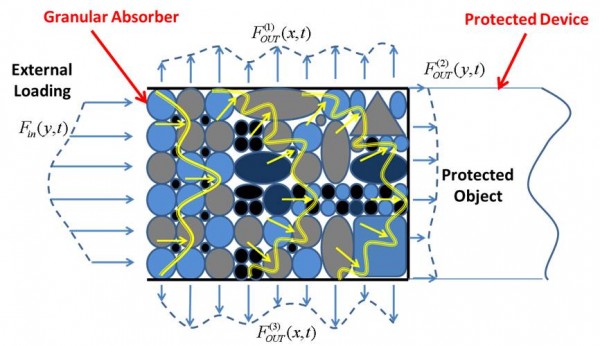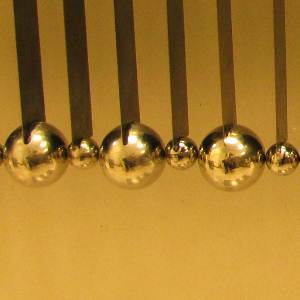גבישים גרגיריים הינם אוסף של גופים קשיחים, בדידים, בעלי צורות ותכונות מכניות שונות ומסודרים במבנה סריגי מסוים (איור 1). מלכתחילה גופים אלה נמצאים במגע וביניהם פועל כוח דחיה לא-לינארי (בדומה לכוחות הרץ הפועלים במגע בין שני גופים כדוריים הסמוכים זה לזה). מחקרים אחרונים בנושא הראו שמערכות גרגריות הן בעלות תכונות דינמיות מיוחדות המתבטאות בהנחתה ושיכוך יעילים של גלי הלם. כמו כן מערכות אלה מאפשרות לוקליזציה, לכידה ופירוק של גלי מאמצים הזורמים בחומר.

איור 1: תאור סכמטי של משכך הלמים דו-מימדי המורכב מאלמנטים קשיחים בעלי תכונות מכניות וצורתיות שונות. התקדמות של גלי מאמצים מתואר ע"י קו רציף, צהוב
אחת המטרות המרכזיות והחשובות העומדות בפני הנדסה מכנית של היום הינה פיתוח שיטות ומנגנונים יעילים להגנה על מערכות מכניות (לדוגמא רכבים, מטוסים, מכשירים הנדסיים, רוטורים וכו') ומיקרו-מכניות (רכיבי MEMS, רכיבי ם אלקטרוניים זעירים) מפני צורות העמסה שונות. פיתוח מנגנוני הגנה יעילים (עבור מבנים הנדסיים שונים) מפני גלי הלם המתפתחים בחלק מסוים של המבנה (לדוגמא כתוצאה מפיצוץ, רעידת אדמה, התנגשות וכד') מהווה אתגר עיקרי כמעט בכל תכנון הנדסי.
תוצאות מחקר של העשור האחרון מעידות על כך שמערכות גרגיריות יכולות לשמש כמשככי הלם מאד יעילים. כך למשל ביצירת תאים העמידים בפני פיצוץ משתמשים בחומרים גרגיריים לריסון מהיר של גלי הלם המתפתחים בדפנות של התא. משכך הלם גרגירי הינו בעל פוטנציאל אדיר גם עבור שימושים צבאיים. לחומר תכונה ייחודית של הסעה מכוונת ובליעה מהירה של אנרגית הלם (פיצוץ) המאפשרת מימוש פוטנציאל זה במלואו.
ממחקרים שערכנו בנושא של דינמיקה של גבישים גרגירים עולה כי הכנסת שינויים בתכונות מכניות וצורתיות של המבנה הגרגירי מביאה לשינויים דרסטיים בתגובה הדינמית של החומר. כך התגובה הדינמית של חומר גרגרי לא אחיד שוכנת בתווך שבין היווצרות גלי הלם המתקדמים ללא שינוי צורה (סוליטונים), לבין הנחתה אלימה ודיספרסיה של גלי הלם.
נכון להיום קיים פער ידע אדיר בין יכולות טכנולוגיות של יצור חומרים גרגיריים בעלי תכונות הנדרשות לבין ההבנה התאורטית הבסיסית המאפשרת תיאור נאות של התגובה הדינמית של חומרים אלה. מיותר לציין שבהעדר מודלים תאורטיים תקפים, תכנון ובנייה של משכך הלם (האמור להיענות לדרישות דינמיות הנקבעות ע"י מערכת הנדסית ספציפית) אינם ברי ביצוע.
אחד מכיווני המחקר הנוכחים המתבצעים בקבוצתו של ד"ר יולי סטרוסבצקי עוסק בפיתוח מודלים תאורטיים המתארים את התגובה הדינמית של חומרים גרגירים לא אחידים. בהתבסס על מודל תאורטי זה אנו מפתחים שיטות חדישות להנחתת גלי הלם בחומר גרגרי, שאמור ללוות את כל שלבי התכנון והיצור של חומרים אדפטיביים החיוניים לבקרת תנועתם של גלי מאמצים.
פרסומים:
- Y. Starosvetsky, Jayaprakash K R* , A. F. Vakakis, ‘ Scattering of Solitary Waves and Excitation of Transient Breathers in Granular Media by Light Intruders ', Journal of Applied Mechanics 79, 011001, (2012)
- Jayaprakash K.R.*, Y. Starosvetsky, A.F. Vakakis, ‘ New Class of Solitary Waves in Granular Dimer Chains with No-Precompression ', Phys. Rev. E 83, 036606 (2011)
- Y. Starosvetsky and A. F. Vakakis, ‘ Primary Wave Transmission in Systems of Elastic Rods with Granular Interfaces', Wave Motion 48, 568-58 (2011)
- Y. Starosvetsky, M. A. Hasan, A. F. Vakakis, L. I. Manevitch, ‘Strongly Nonlinear Beat Phenomena and Energy Exchanges in Weakly Coupled Granular Chains on Elastic Foundations', Accepted for publication in SIAM Journal of Applied Mathematics (2010)







